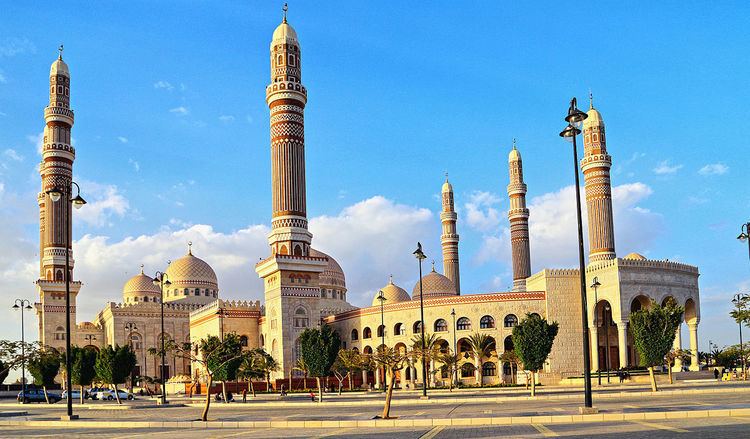Location YEM District Sana'a State Yemen Opened 21 November 2008 Leadership Ali Abdullah Saleh Municipality Sana'a | Affiliation Islam Prefecture Sana'a Ecclesiastical or organizational status In use Capacity 44,000 Region Yemen Year consecrated November 2008 | |
 | ||
Address 70 Meters Rd, Sana'a, Yemen Similar Great Mosque of Sana'a, Emir Abdelkader Mosque, Bab al‑Yaman, Al‑Khadra Mosque, National Museum of Yemen | ||
One of the most beautiful adhaan ever yemen sana a saleh mosque
The Saleh Mosque or Al Saleh Mosque (Arabic: جامع الرئيس الصالح) is the largest and most modern mosque in Sana'a, Yemen. It lies in the southern outskirts of the city, south of the Al Sabeen Maternal Hospital. Inaugurated in November 2008 by Yemeni President Ali Abdullah Saleh, it is named in his honor. The mosque, 27,300 square metres (294,000 sq ft) in size, has a central hall which is 13,596 square metres (146,350 sq ft) with an occupancy capacity of 44,000. The building cost nearly US$60 million to construct. Open to non-Muslims, the mosque is frequented by tourists, and promotes moderate Islam. Security measures include police and bomb-sniffing dogs.
Contents
- One of the most beautiful adhaan ever yemen sana a saleh mosque
- Al saleh mosque sanaa
- History
- Architecture and fittings
- Grounds
- Worshippers
- References
Al saleh mosque sanaa
History
The President of Yemen was criticized in 2008 for undertaking such a grand project when the country was suffering with socio-economic problems. Several accidents occurred during its construction. The minarets collapsed multiple times, resulting in some deaths. After these occurrences, the site was used to build the Islamic college and the garden next to the mosque. It is also mentioned that Hayel Said, a local businessman, was threatened with reprisals and annulment of his business licenses if he did not pay for the building of the mosque. It is also reported that because of the fluid political situation in Yemen where the Zaidi tribal elites are influential, the Saleh's palace mosque was bombed in June 2011 with the president badly injured; the bombing took place at the instigation of tribal elites who supported the youth movement which sought a national leadership change.
The Saleh Mosque appears on Yemeni currency. It is depicted on the face of the 2007 issue 250 rial note.
Architecture and fittings
The mosque was constructed using different types of stone, including black basalt stones as well as limestone in red, white and black. The building is compared in its beauty and architectural elegance with the Masjid al-Haram, in Mecca. It was built in a fusion of "Yemeni architecture and Islamic styles", with many Quranic verses inscribed on the walls. The layout is referred to as "Himyarite architecture".
The building has wooden roofs and seven ornate domes. There are five domes in the main roof, the main dome measuring 27.4 metres (90 ft) in diameter with a height of 39.6 metres (130 ft) above the mosque's roof. The other four domes measure 15.6 metres (51 ft) with height of 20.35 metres (66.8 ft) above the roof level of the mosque. Windows fitted with stained glass are locally referred to as qamariyah. Of the fifteen wooden doors, ten of them are situated on the eastern and western sides, and five open south towards the Islamic college and ablution areas. The doors are 22.86 metres (75.0 ft) in height and include engraved copper patterns. Four of the six minarets are 160 metres (520 ft) in height.
The interior space is 24 metres (79 ft) from floor to ceiling. While the plush carpeting contains intricate patterns, huge chandeliers have colorful and flower-like patterns. The three-storied building which includes the Quran College, also contains libraries and over two dozen classrooms, enough space to accommodate 600 students. Three large rooms are specifically for women; a small hall can accommodate 2,000 women.
The mosque has a modern central air conditioning and sound systems, as well as full security arrangements, including bomb-sniffing dogs. The building stays lit through the night. Thorn Lighting International, through its distributor Al Zaghir, was the lighting contractor. Diah International served as the subcontractor for civil and mechanical engineering; Sodaco Engineering & Contracting also provided services in the building's construction.
Grounds
Situated in close proximity to the Presidential palace, the mosque is set within the Al Sabeen square, which is the country's largest parade square. The mosque was built on a large area of land which was acquired from Beit Zuhra, of a well-known local family; it is said that when Zuhra refused to sell the land at a low price, his eldest son was abducted for ransom and released three months later, after Zuhra agreed to sell the land for the mosque at a low price. Nearby is an amusement park named FunCity. The grounds include sprawling gardens, green courtyards, and parking space for thousands of vehicles, part of an integrated services plan.
Worshippers
As people of all religions can visit the mosque, tourists are present in large numbers. The mosque also promotes moderate Islam, to a large number of people, which is considered a positive feature in the light of the Al-Qaeda influence. Women pray in an enclosed area separated from the main central hall. The Saleh Mosque is the only Yemeni mosque where police and bomb-sniffing dogs are used for inspecting worshippers. Prayers are also broadcast over the national television network to reach a larger viewing audience.
